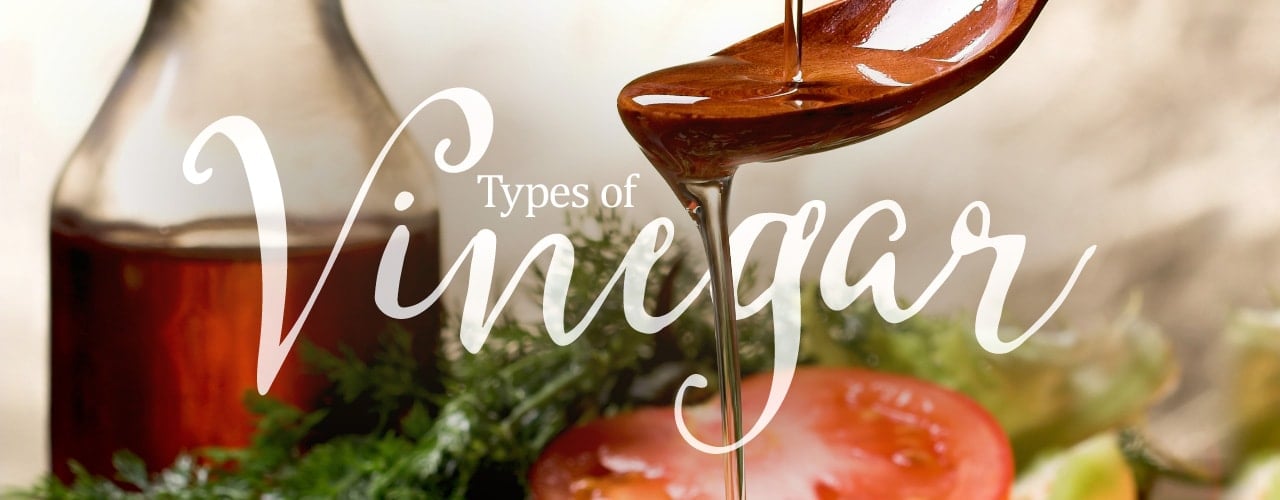
Types of Vinegar
Last updated on 11/3/2022Vinegar is a go-to ingredient when you want to increase the acidity in your recipes or preserve foods through pickling. It can help to cut the saltiness of over-seasoned dishes, and it can be combined with salad oil to create a tangy vinaigrette. Vinegar has a long shelf-life, which makes it convenient to keep on hand. To top it off, there are many different kinds of vinegar to choose from. We'll introduce the different kinds of vinegar and explain what makes each type unique.
Shop All Bulk VinegarWhat Is Vinegar Made Of?
Vinegar is made of water and acetic acid. All types of vinegar start as a liquid containing natural yeasts and sugars, like unpasteurized fruit juice. The liquid goes through a fermenting process where the yeast consumes the sugar and produces ethanol (alcohol). The sour, pungent flavor of vinegar is deepened through a second fermentation that transforms the alcohol into acetic acid. The flavor profile of each kind of vinegar is determined by the type of juice or liquid that is used.
Different Types of Vinegar
Have you ever wondered about the difference between apple cider vinegar and white vinegar? We've made a list of vinegar types and their flavor profiles to help you choose the best vinegar for the job.
1. Distilled White Vinegar
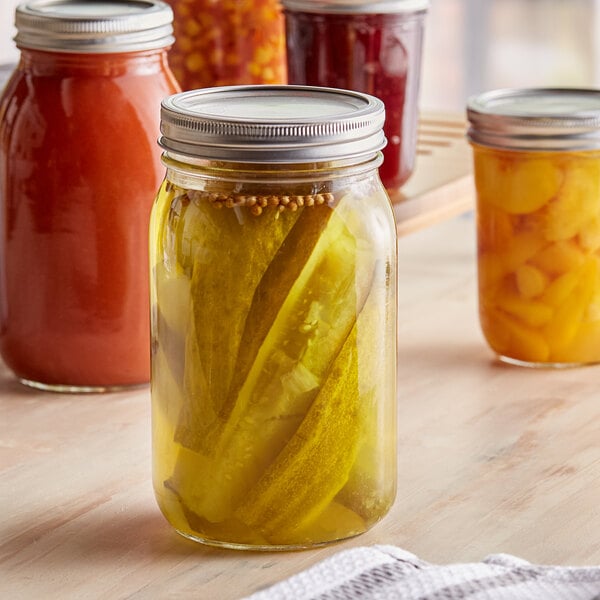
White vinegar is the most common type of vinegar, and there’s a good chance it’s sitting in your kitchen right now. It offers a sharp taste and potent smell, making it one of the most distinct vinegar types on this list. That’s because white vinegar is distilled from grain, which results in a crisp and clear product.
White vinegar has a strong flavor, so it's best used in small doses to add a touch of acidity to recipes. It’s a common preserving agent and can be used to pickle foods. Distilled vinegar can also be used in baking applications to provide leavening (rise) to cakes and cupcakes. White vinegar is an effective cleaner for surfaces and cookware, and it can be used in your coffee maker to remove scale buildup.
- White Vinegar Flavor: Sharp and potent
- Best White Vinegar Uses: Preserving and pickling, cleaning, leavening baked goods
- What Is White Vinegar Made From? Grain alcohol
2. Apple Cider Vinegar

Apple cider vinegar is the next most common type of vinegar on our list. It’s made by adding a bacteria and yeast culture to crushed, strained apples. Added sugars and natural sugars are consumed by the bacteria and yeast, producing ethanol. The ethanol is fermented a second time to produce acetic acid, the compound that gives vinegar its sour flavor.
Apple cider vinegar has a golden hue and can be used to add a tart and subtle fruity flavor to marinades, salad dressings, coleslaw, and chutneys.
Apple Cider Vinegar vs White Vinegar
Apple cider vinegar is different than white vinegar because it retains a sweet, fruity flavor from the apples. White vinegar is stronger than apple cider with a higher percentage of acetic acid. Reach for apple cider vinegar when you want to add flavor to salad dressings and sauces. Choose distilled white vinegar when you want to pickle foods or add acidity without imparting any extra flavors.
- Apple Cider Vinegar Flavor: Tart and fruity
- Best Apple Cider Vinegar Uses: Health tonics, salad dressings, and marinades
- What Is Apple Cider Vinegar Made From? Crushed apples, sugar, and yeast
3. Balsamic Vinegar

This Italy native is the only type of vinegar that is not produced by fermenting alcohol. Like a fine wine, balsamic vinegar is made by aging pressed grapes in oak barrels. And just like wine, the older the balsamic, the higher the price tag. True balsamic vinegar will carry a label that reads D.O.P. (Protected Designation of Origin). This certifies that the balsamic vinegar was produced according to protected standards.
Balsamic vinegar has a distinct sweet and zesty flavor that can be drizzled over both savory and sweet dishes. Or, mix it with olive oil for a classic balsamic vinaigrette dressing.
- Balsamic Vinegar Flavor: Concentrated, complex, and sweet
- Best Balsamic Vinegar Uses: Salad dressings, glazes, reductions
- What Is Balsamic Vinegar Made From? Grape must (pressed grape juice)
4. White Wine Vinegar
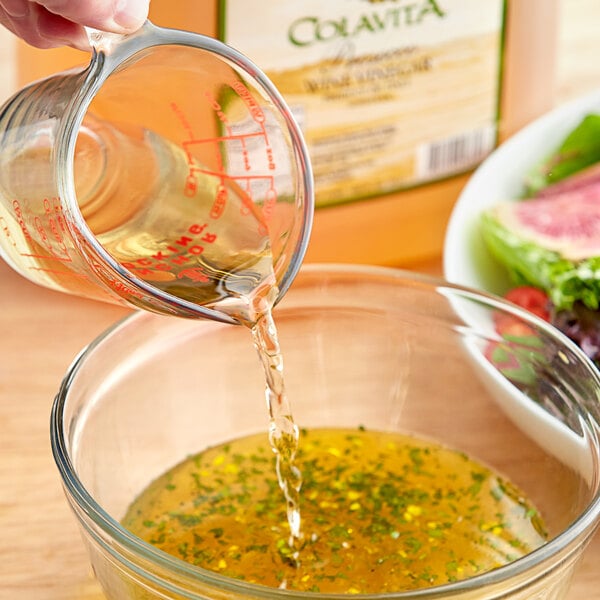
Not to be confused with distilled white vinegar, this vinegar has a much milder flavor. White wine vinegar is made with fermented white wine and is much less acidic than both white and apple cider vinegar. The light, balanced sweetness of white wine vinegar makes it a refreshing addition to salad dressings and soups.
White Vinegar vs White Wine Vinegar
Both of these types of vinegar have "white" in their name, but their flavor is very different. Distilled white vinegar is very strong and can easily overpower foods if you use too much. White wine vinegar is milder than distilled vinegar and has more culinary uses because of its complex flavor. Reach for the white vinegar for canning or cleaning, and use white wine vinegar for creating delicious sauces and marinades.
- White Wine Vinegar Flavor: Sweet and mild
- Best White Wine Vinegar Uses: Pickling and brining, salad dressings, condiments, sauces, marinades
- What Is White Wine Vinegar Made From? White wine
Back to Top
5. Red Wine Vinegar
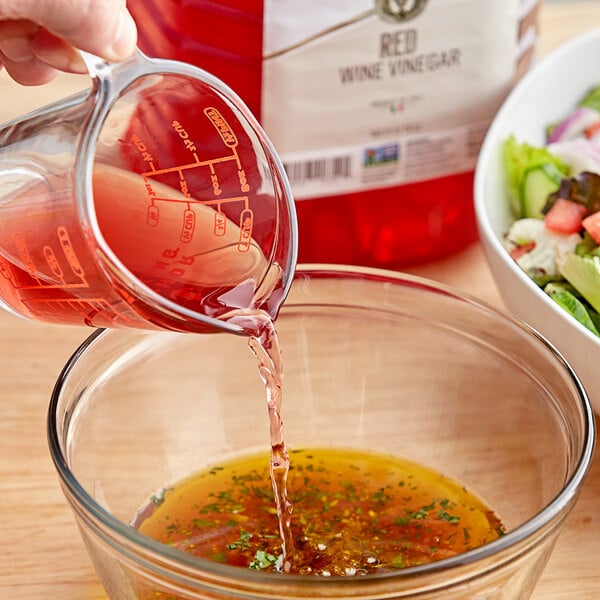
Red wine vinegar is similar to its white wine counterpart. It’s derived from a red wine base and offers a sweet, less acidic taste. This Mediterranean staple has a mellow flavor profile that is perfect for use in vinaigrettes and reductions.
Is Red Wine Vinegar the Same as Red Cooking Wine?
No, red wine vinegar and red cooking wine are not the same ingredients. Red wine vinegar is made from fermented red wine, so it has a tangy flavor that enhances vinaigrettes and marinades. Red cooking wine, on the other hand, is a product that contains red wine along with preservatives, sodium, and sweeteners. Experienced chefs recommend using drinking wine instead of cooking wine for a higher quality dish.
- Red Wine Vinegar Flavor: Tangy and sweet
- Uses for Red Wine Vinegar: Mignonette (condiment served with raw oysters and clams), pickling vegetables, salad dressings, marinades, sauces
- What Is Red Wine Vinegar Made From? Red wine
6. Rice Wine Vinegar
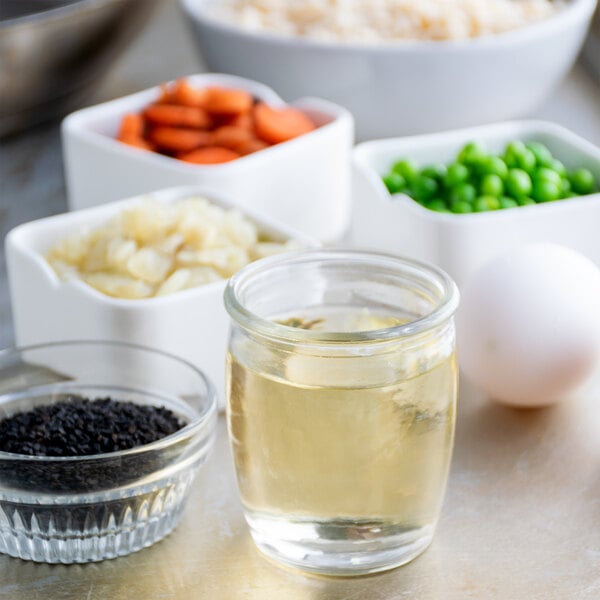
A familiar ingredient in Asian cuisine, rice vinegar is made by fermenting rice into alcohol, then fermenting the alcohol into acidic acetic acid. Rice wine vinegar has a sweeter flavor than white wine or red wine vinegar. It's also the key ingredient in the sushi vinegar that gives sushi rice its flavor and texture.
Rice Wine Vinegar vs Rice Wine
Rice wine and rice vinegar are two different ingredients. Rice wine is made from fermented rice, which produces a sweet flavor. Rice wine vinegar goes through a second fermentation, which adds more tang. These two ingredients cannot be substituted for each other.
- Rice Vinegar Flavor: Sweet and delicate
- Best Rice Vinegar Uses: Sushi rice, salad dressings, sauces, marinades
- What Is Rice Vinegar Made From? Fermented rice
7. Malt Vinegar

Malt vinegar gets its name from malted barley. To make this amber-colored vinegar, grains of malted barley are fermented into ale, then fermented a second time to develop the tart, toasty flavor.
Malt vinegar is the type of vinegar served with fresh-cut french fries or with the classic British dish, fish and chips. But don't neglect this vinegar in your cooking. You can also use malted vinegar to pickle vegetables and flavor sauces.
- Malt Vinegar Flavor: Toasty and rich
- Best Malt Vinegar Uses: Flavor enhancer for chips and french fries, pickled vegetables, salad dressings, condiments, sauces
- What Is Malt Vinegar Made From? Malted barley
8. Red Rice Vinegar
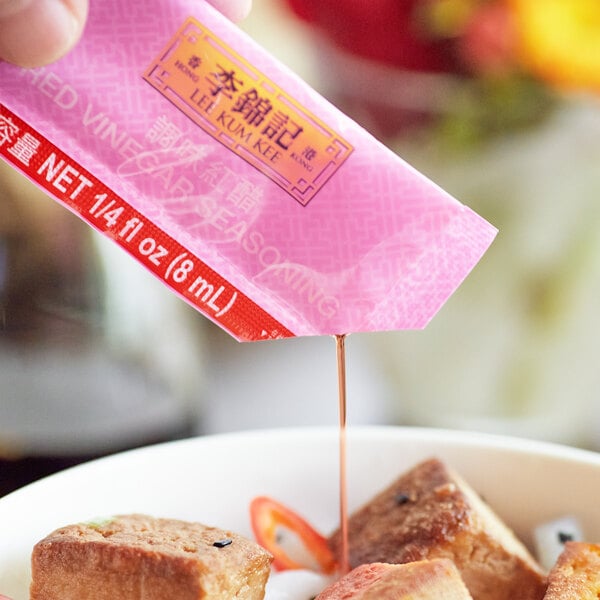
Red rice vinegar is also known as Chinese red vinegar. Even in Chinese cooking, it's not a commonly used vinegar. But in certain traditional recipes, it's a necessity and cannot be substituted. Congee (rice porridge) and Chinese fried squab (pigeon) are two dishes enhanced with red rice vinegar.
The key ingredient of red rice vinegar is rice cultivated with red mold. This rice is referred to as red yeast rice and it gives red vinegar its signature salty flavor.
- Red Rice Vinegar Flavor: Tart and salty
- Best Red Rice Vinegar Uses: Chinese dishes and condiments
- What Is Red Rice Vinegar Made From? Fermented red rice
Back to Top
9. Champagne Vinegar

Champagne vinegar is a type of white wine vinegar made from the same grapes used to make Champagne. It's not actually made with a bottle of bubbly Champagne, which is a common misconception. But like Champagne, this vinegar is sweet and effervescent. It won't overpower the flavors in your delicate sauces and marinades.
Substitute for Champagne Vinegar
In recipes calling for Champagne vinegar, the best substitute to replicate the delicate flavor is rice wine vinegar. You can use white wine vinegar, but its flavor is more acidic so opt for a lesser amount than you would normally use.
- Champagne Vinegar Flavor: Floral and sweet
- Best Champagne Vinegar Uses: Quick pickles, salad dressings, sauces
- What Is Champagne Vinegar Made From? Chardonnay or pinot noir grapes
10. Sherry Vinegar

A close cousin of balsamic vinegar, sherry vinegar is an ingredient that can pack a big punch into your favorite recipes. Its nutty, rich flavor offers less sweetness than balsamic vinegar. It’s also potent, which means that it should be used sparingly – especially as a substitution.
The recipe for sherry vinegar was discovered by accident. This Spanish native vinegar is said to be the result of a few barrels of sherry that were spoiled and became too acidic. While this ruined the after dinner drink, it produced a new favorite ingredient for chefs.
- Sherry Vinegar Flavor: Pungent and nutty
- Best Sherry Vinegar Uses: Salad dressings, glazes, marinades, reductions
- What Is Sherry Vinegar Made From? Fortified wine
11. Black Vinegar (Chinkiang)
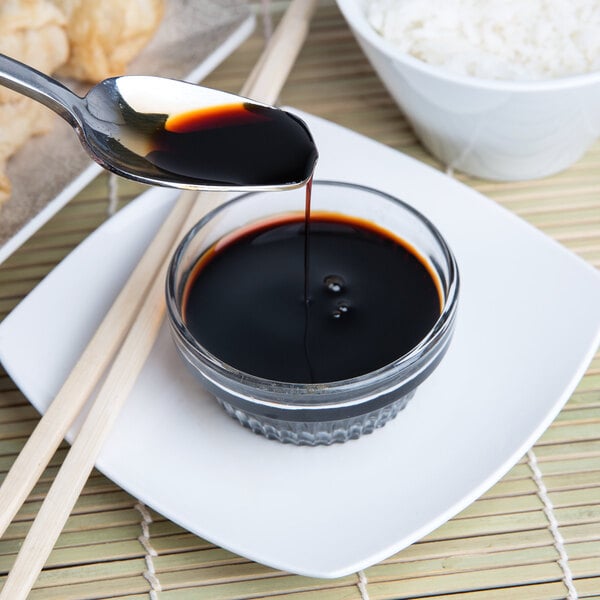
Black vinegar, also known as Chinkiang vinegar, hails from the eastern Chinese city of Zhenjiang. It offers an earthy and smoky umami flavor thanks to a combination of fermented glutinous rice, wheat, and millet. This pantry staple for Chinese cuisine can be used to pair with dumplings, duck, and Asian dipping sauces.
Substitute for Chinese Black Vinegar
Black vinegar has such a unique flavor that it's hard to replicate its aromatic qualities with other types of vinegar. But in a pinch, you can substitute a combination of rice wine vinegar with soy sauce.
- Black Vinegar Flavor: Earthy and umami
- Best Black Vinegar Uses: Flavor enhancer for stir-fry, meats, and sauces
- What Is Black Vinegar Made From? Fermented black sticky rice or glutinous rice, sometimes with other added grains
12. Cane Vinegar

This type of vinegar is produced by fermenting the syrup extracted from crushed sugar cane. While cane vinegar is derived from sugar cane, it offers a surprisingly un-sweet flavor profile often compared to malt vinegar.
Cane vinegar is more common in countries where sugar cane is grown. It's a staple ingredient in Filipino dishes like chicken adobo (chicken simmered in vinegar).
- Cane Vinegar Flavor: Mellow and fresh
- Best Cane Vinegar Uses: Traditional Filipino dishes, sauces, marinades
- What Is Cane Vinegar Made From? Sugar cane
13. Beer Vinegar
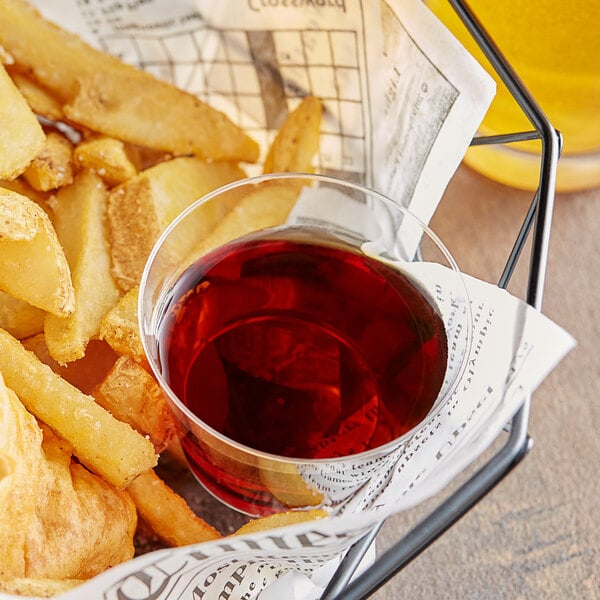
Just as it sounds, beer vinegar is made by fermenting any type of finished beer. It offers a very similar flavor profile to barley-based malt vinegar, which makes it an ideal alternative to use with classic fish and chips. Beer vinegar can be made with any type of beer, which results in a range of flavors. From stouts to pale ales, each type will create a unique taste.
- Beer Vinegar Flavor: Nutty and complex
- Best Beer Vinegar Uses: Flavor enhancer for
- What Is Beer Vinegar Made From? Beer
Back to Top
Vinegar FAQ
We answer some common questions about vinegar below. Check out our vinegar chart to compare the colors of the most popular types of vinegar.

How Is Vinegar Made?
Vinegar is made using a two-step fermentation process. First, a liquid mixture containing yeast and sugar is fermented into alcohol. Then the alcohol goes through a second fermentation which produces a sour- or bitter-tasting product packed with acetic acid.
Does Vinegar Go Bad?
Just because your vinegar has turned cloudy or the color appears to change doesn’t mean it has gone bad. Thanks to the acidic nature of vinegar, it can be kept on your shelf indefinitely. Store it in a cool, dry place away from heat and light, and always keep a tight lid on the bottle.
Over time, the appearance of your vinegar may change, including a shift in color or the development of sediment towards the bottom of the bottle. This can occur naturally in vinegar over time, but should not affect the taste. Types of vinegar with a higher acidity level, including distilled white or apple cider vinegar, are more likely to experience these changes. If you prefer, you can simply filter out the sediment using a paper coffee filter.
What Is the Mother of Vinegar?
A vinegar mother is a gelatinous mass of cellulose and bacteria (mycoderma aceti) that serves as a vinegar starter. The bacteria in the mother feeds off alcohol and turns it into acetic acid, the compound that gives vinegar its flavor. Sometimes a mother of vinegar will form on storebought vinegar that still has traces of unfermented alcohol. It's harmless to consume and will not affect the taste of the vinegar surrounding it.
Because of its acidity, vinegar can be used to balance out the flavors in your dishes. Try the different types of vinegar on our list to create unique flavor profiles. This powerhouse ingredient lends itself to a wide variety of uses in a commercial kitchen.






